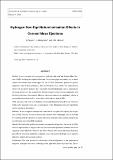Files in this item
Hydrogen non-equilibrium ionisation effects in coronal mass ejections
Item metadata
| dc.contributor.author | Pagano, Paolo | |
| dc.contributor.author | Bemporad, Alessandro | |
| dc.contributor.author | Mackay, Duncan Hendry | |
| dc.date.accessioned | 2020-03-27T16:30:01Z | |
| dc.date.available | 2020-03-27T16:30:01Z | |
| dc.date.issued | 2020-05 | |
| dc.identifier | 267090942 | |
| dc.identifier | dd697484-893b-4eb3-b12c-89eb6e1e7bb5 | |
| dc.identifier | 000536189300006 | |
| dc.identifier | 85087198608 | |
| dc.identifier.citation | Pagano , P , Bemporad , A & Mackay , D H 2020 , ' Hydrogen non-equilibrium ionisation effects in coronal mass ejections ' , Astronomy & Astrophysics , vol. 637 , A49 . https://doi.org/10.1051/0004-6361/202037638 | en |
| dc.identifier.issn | 0004-6361 | |
| dc.identifier.other | ORCID: /0000-0001-6065-8531/work/79917867 | |
| dc.identifier.uri | https://hdl.handle.net/10023/19722 | |
| dc.description | This research has received funding from the Science and Technology Facilities Council (UK) through the consolidated grant ST/N000609/1 and the European Research Council (ERC) under the European Union Horizon 2020 research and innovation program (grant agreement No. 647214). D.H.M. would like to thank both the UK STFC and the ERC (Synergy grant: WHOLE SUN, grant Agreement No. 810218) for financial support. D.H.M. and P.P. would like to thank STFC for IAA funding under grant number SMC1-XAS012. This work used the DiRAC@Durham facility man-aged by the Institute for Computational Cosmology on behalf of the STFC DiRAC HPC Facility (www.dirac.ac.uk. The equipment was funded by BEIS capital funding via STFC capital grants ST/P002293/1, ST/R002371/1 and ST/S002502/1,Durham University and STFC operations grant ST/R000832/1. DiRAC is part of the National e-Infrastructure. We acknowledge the use of the open source (gitorious.org/amrvac) MPI-AMRVAC software, relying on coding efforts from C. Xia, O.Porth, R. Keppens. CHIANTI is a collaborative project involving George Mason University, the University of Michigan(USA), University of Cambridge (UK) and NASA Goddard Space Flight Center (USA). | en |
| dc.description.abstract | Context. A new generation of coronagraphs used to study solar wind and coronal mass ejections (CMEs) are being developed and launched. These coronagraphs will heavily rely on multi-channel observations where visible light (VL) and UV-EUV (ultraviolet-extreme ultraviolet) observations provide new plasma diagnostics. One of these instruments, Metis on board ESA-Solar Orbiter, will simultaneously observe VL and the UV Lyman-α line. The number of neutral hydrogen atoms (a small fraction of coronal protons) is a key parameter for deriving plasma properties, such as the temperature from the observed Lyman-α line intensity. However, these measurements are significantly affected if non-equilibrium ionisation effects occur, which can be relevant during CMEs. Aims. The aim of this work is to determine if non-equilibrium ionisation effects are relevant in CMEs and, in particular, when and in which regions of the CME plasma ionisation equilibrium can be assumed for data analysis. Methods. We used a magneto-hydrodynamic (MHD) simulation of a magnetic flux rope ejection to generate a CME. From this, we then reconstructed the ionisation state of hydrogen atoms in the CME by evaluating both the advection of neutral and ionised hydrogen atoms and the ionisation and recombination rates in the MHD simulation. Results. We find that the equilibrium ionisation assumption mostly holds in the core of the CME, which is represented by a magnetic flux rope. In contrast, non-equilibrium ionisation effects are significant at the CME front, where we find about 100 times more neutral hydrogen atoms than prescribed by ionisation equilibrium conditions. We find this to be the case even if this neutral hydrogen excess might be difficult to identify due to projection effects. Conclusions. This work provides key information for the development of a new generation of diagnostic techniques that aim to combine visible light and Lyman-α line emissions. The results show that non-equilibrium ionisation effects need to be considered when we analyse CME fronts. Incorrectly assuming equilibrium ionisation in these regions would lead to a systematic underestimate of plasma temperatures. | |
| dc.format.extent | 10 | |
| dc.format.extent | 362400 | |
| dc.language.iso | eng | |
| dc.relation.ispartof | Astronomy & Astrophysics | en |
| dc.subject | Magnetohydrodynamics (MHD) | en |
| dc.subject | un: coronal mass ejections (CMEs) | en |
| dc.subject | Sun: UV radiation | en |
| dc.subject | Methods: data analysis | en |
| dc.subject | QB Astronomy | en |
| dc.subject | QC Physics | en |
| dc.subject | 3rd-DAS | en |
| dc.subject.lcc | QB | en |
| dc.subject.lcc | QC | en |
| dc.title | Hydrogen non-equilibrium ionisation effects in coronal mass ejections | en |
| dc.type | Journal article | en |
| dc.contributor.sponsor | Science & Technology Facilities Council | en |
| dc.contributor.sponsor | European Research Council | en |
| dc.contributor.sponsor | European Research Council | en |
| dc.contributor.institution | University of St Andrews. Applied Mathematics | en |
| dc.identifier.doi | 10.1051/0004-6361/202037638 | |
| dc.description.status | Peer reviewed | en |
| dc.identifier.grantnumber | ST/N000609/1 | en |
| dc.identifier.grantnumber | 647214 | en |
| dc.identifier.grantnumber | 810218 | en |
This item appears in the following Collection(s)
Items in the St Andrews Research Repository are protected by copyright, with all rights reserved, unless otherwise indicated.

